| 1 | Colombia’s worst coral snake |
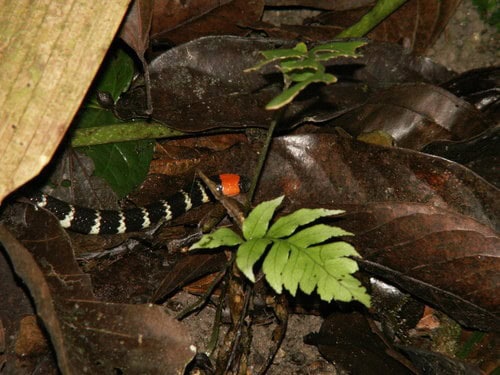
Along with venomous lanceheads, coral snakes are the main reason not to enter a South American rainforest without an experienced guide, and the most common species in Colombia is easily the red-tailed coral snake (Micrurus mipartitus). This is a highly dangerous species which generates various three-finger neurotoxins in its venom glands, and reaches a maximum of 140.6cm.
Red-tailed coral snakes inhabit the entire west of Colombia, as they occur west of the Andes mountain range. They’re also found in northern Ecuador, northwest Venezuela, Panama, and finally Costa Rica, where they’re far rarer.
The natural habitat of Micrurus mipartitus is rainforests and cloud forests, but they’re also common in disturbed forests with piles of timber. They stray into villages and even into swimming pools, and are a notorious inhabitant of coffee bean and sugarcane plantations. They tend to bury themselves in the upper few centimetres of leaf litter, making them difficult to spot. Micrurus mipartitus is one of a Colombian coffee bean picker’s top fears, although with their bright colours, they’re much easier to notice in mulchy undergrowth than the fer-de-lance, another coffee plantation lurker.
Colombia ranks third for coral snake species, with 28 known to occur there. However, red-tailed coral snakes are undoubtedly the most frequently encountered.
| 2 | Easy to recognise |
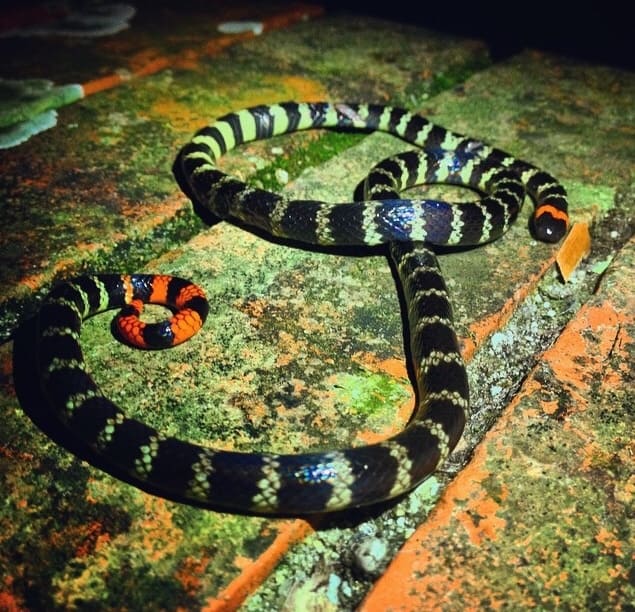
Some coral snake species are tricky to distinguish. For example, the eastern and Texas coral snakes are independent species, yet are only separated by the width of their black neck collar. Meanwhile, nobody could fail to recognize the red-tailed coral snake.
First is their namesake red-tail, which forms 4-5 bands, with black inbetween. They also have a bright red neck collar, giving the head and tail a similar appearance. This might be to confuse bird predators, preventing them from attacking the brain.
On the body, meanwhile, there isn’t a trace of red, which is unusual for a coral snake. Their patterns consist of 34-84 rapidly alternating black-white bands.
On the head, the red band falls just short of their eye. Their face is pure black, which blends with their eyes, which have round pupils.
Red-tailed coral snakes only vary subtly. Some individuals have a brown base instead of black – see this image of two dueling red-tailed coral snakes. Occasionally, you can find individuals lacking white bands, with an iridescent black sheen instead. But the dual red head and red-striped tail are virtually always in place.
| 3 | Causes relatively few bites |
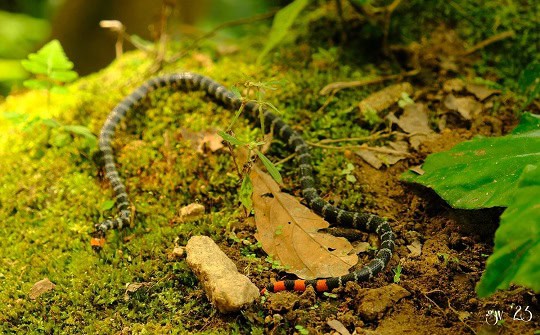
The venom of red-tailed coral snakes is neurotoxic like most of its kin. A specific ingredient is the three-finger toxin Mipartoxin-I, which acts post-synaptically, similarly to a black mamba’s, blocking acetylcholine neurotransmitter receptors in muscle cells. This toxin was highly lethal when tested against mammals and birds. Red-tailed coral snakes contain a higher proportion of three-finger toxins than Dumeril’s coral snake, another common species in Colombia, at 61% versus 28%.
Despite this doom, the coral snake family is estimated to cause less than 1% of snakebites in South America, and no more than 3% in Colombia. In one estimate, coral snakes caused just 0.4% of Colombian snakebites.
Red-tailed coral snakes are no more aggressive than their cousins. They tend not to react if humans walk past them in a leafy forest clearing, unlike a fer-de-lance, which will coil and hiss, or even strike without warning. Red-tailed coral snakes are most likely to bite if picked up, or if you surprise them or step on them. Due to their short fangs, they’re forced to hold their fangs into a human’s arm for longer – the quicker you rip them off the better.
| 4 | No swelling, lots of lung failure |
Micrurus mipartitus has never been witnessed eating mammals in the wild, but their venom still causes mice to enter respiratory failure and die. A human case involved a 22 year old soldier, who was bitten near the Colombian town of Jamundí in 2010.
The man was bitten between his fingers on the right hand. The first symptoms were mild pain and tingling (paresthesia), arriving 30 minutes later. Within an hour, he was experiencing drooping eyelids (ptosis) on both sides, and dysarthria, trouble speaking due to weakened speech muscles. This was a mere taste of the neurotoxic symptoms to come, and at 3 hours post bite, the soldier was struggling to walk and experiencing progressive respiratory distress.
The man was transported to hospital via helicopter, where his pulse was found to be an elevated 94 beats per minute. The bite site showed little more than a mild swelling, which is typical for primarily neurotoxic snakes. By now, flaccid paralysis was kicking in, the loss of most muscle control. The man was placed on artificial intubation, requiring support to breath and suck in oxygen.
The solider was then administered 6 vials of coral snake antivenom. Gradually, the neurotoxic symptoms eased. The man was taken off incubation at 20 hours, and released from hospital at 24 hours.
| 5 | Muteness and drooping eyelids |
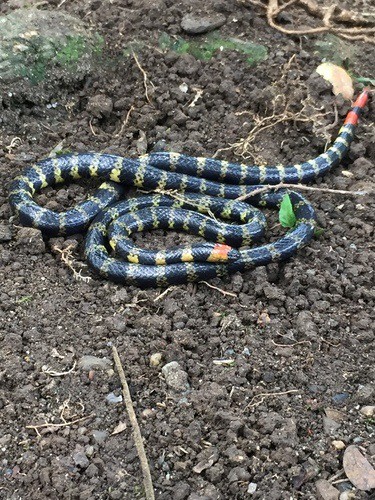
The study also documented a female bite victim aged 47, who was bitten on the left foot. Her symptoms were very similar to the male soldier. They began with moderate pain and tingling (parasthesia) in her foot and leg, at 30 minutes post bite, before progressing to drooping eyelids, trouble speaking, difficulty walking, and decreased upper limb strength.
After reaching hospital at the 2 hour mark, the woman was experiencing progressive respiratory depression, with each inhalation producing a smaller expansion of her chest. The woman was forced to be placed on artificial ventilation. Again, she received 8 vials of antivenom, and recovered especially rapidly, with most neurotoxic symptoms fading within 6 hours. Like the soldier, there were virtually no local symptoms. The bite wound swelled slightly, but no more.
Red-tailed coral snake bites follow a similar pattern. The neurotoxins begin by affecting the cranial nerve synapses, hence the speech difficulties and drooping eyelids. The nerves controlling the lung muscles are affected in the next phase. The single most lethal toxin in red-tailed coral snake venom is Mipartoxin, which makes up 28% of the venom.
| 6 | Wrestles food from rivals |
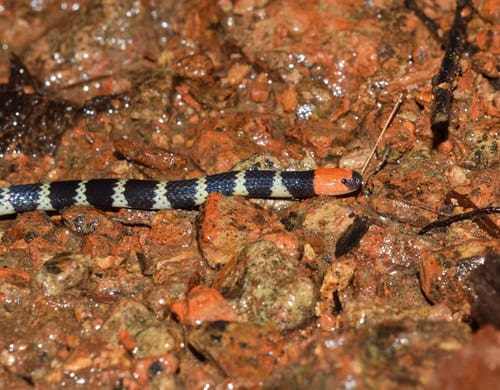
Red-tailed coral snakes host one of the freakiest records: the first snakes in the Elapid family to fight over food. Kleptoparasitism, AKA stealing food from another animal’s clutches, has been recorded in wild snakes multiple times. In 2024, scientists were walking a dirt road in a rainforest, in Colombia’s Valle del Cauca department. They stumbled across two red-tailed coral snakes, battling over a long blue object. It was a caecilian, and the two snakes were tugging the prey back and forth.
Instead of opposite ends, both coral snakes were biting the caecilian near the head. After 2 minutes, the snakes starting rotating on their axis, like a crocodile performing a death roll, while maintaining their grip on the caecilian. The coral snakes continued the tug of war for another 10 minutes, until the ultimate winner broke free and eagerly lunged for the head itself, establishing a grip. Amid the furious battle, any thought of the caecilian actually escaping was forgotten.
The loser coral snake then bit its rival, sinking its fangs in for 30 seconds, although the scientists believed this was accidental. This triggered the winner to finally wrench the caelian free from its opponent. The winner coral snake dragged the meal away into the undergrowth, and the demoralised loser made no attempt to follow.
While captive snakes occasionally fight over food, it’s almost unheard of in the wild.
| 7 | Strongly prefers legless prey |
Micrurus mipatritus is very difficult to keep in captivity, as they refuse to accept food. Most die before 6 months, and only a few have lasted beyond 1 year.
In the wild, at least three snake species are confirmed in their diet: Werner’s ground snake, the Manizales ground snake, and Caqueta blind snakes (Trilepida brevissima). In fact, the latter species was first discovered in 1925 when it tumbled out of a red-tailed coral snake’s stomach.
The caecilian the two were battling over earlier wasn’t fully identified, but a confirmed prey is Thompson’s caecilian (Caecilia thompsoni), a species endemic to Colombia. Other confirmed prey include purple caecilians (Gymnopis multiplicata) and the legless lizard Stacy’s bachia. While not strictly eating snakes, red-tailed coral snakes definitely prefer elongated prey.
As for its own predators, none are currently known. But it isn’t that Micrurus martptitus has discovered a great secret, or that its venom scares everyone off. Central American coral snakes are preyed on by nine-banded armadillos and motmots. The truth is that most research has focused on their paralyzing venom so far, and diet and predator records are based off scattered observations rather than full scale studies.
| 8 | Hijacks GABA receptors? |
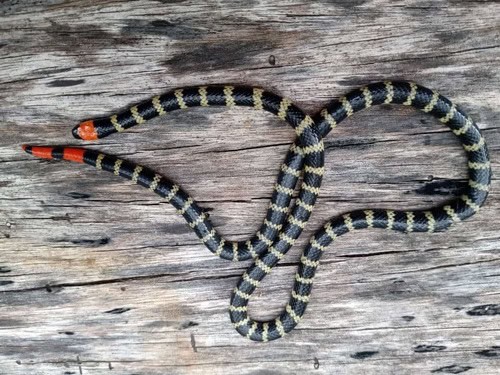
In 2015, scientists announced the discovery of the rarest mechanism for defeating prey in the entire snake kingdom – toxins that caused their prey to have seizures. For years, they had been studying two unusual neurotoxins extracted from coral snake venom in Costa Rica. These were dubbed MmTX1 and MmTX2, or more colloquially, the micrurotoxins, after the Latin family name for coral snakes (Micrurus).
Traditionally, neurotoxins in coral snakes or black mambas cause paralysis by binding to and blocking nicotinic acetylcholine receptors lining nerve cells in muscles. These prevent brain signals from binding, therefore paralysing the victim. But when MxTX was injected into cell preparations coated with ACH receptors, nothing happened. This was despite them having a very similar structure to traditional three-finger neurotoxins. There was clearly a secret, hidden mechanism.
The scientists then exposed the MmTX to radioactive isotopes, allowing them to track their bodily distribution. Instead of ACH receptors, the MmTX cells clearly bound to GABA(A) receptors, in both the brain and spinal chord. In fact, the two MmTXs were 100 times stronger than any previous known GABA-A inhibitor, easily defeating the likes of picrotoxin (PTX), a toxin extracted from the Indian climbing plant Anamirta cocculus.
| 9 | The snake that triggers seizures |
In previous studies on mice, MmTX1 and MmTX2 had triggered seizures, as you’d expect from severe GABA receptor disruption. GABA receptors are how alcohol promotes relaxation, and how pharmaceutical benzodiapamines (benzos) relieve anxiety. Conversely, withdrawal can cause painful seizures, as seen by alcoholics going cold turkey too quickly, without tapering off as advised.
The two MmTXs were the first ever GABA receptor disruptors found in a snake venom. Specifically, the micrurotoxins bound to an unusual site on the GABA receptor. The scientists used muscimol, another GABA receptor blocker. This is the semi-hallucogenic compound extracted from the red and white fly agaric mushroom, a staple of fairy tale illustrations. They found that MmTX only inhibited 40% of muscimol’s binding action on GABA receptors, hinting that it was highly specific.
It turned out that MmTX bound to a site which warped the entire GABA receptor’s shape, preventing it from closing after receiving GABA molecules. This left it open for far too long, preventing the receptor from resetting itself. The receptors began to misfire en masse, thus triggering a seizure.
| 10 | Actually a different species |
This 2015 study burst onto many headlines, announcing the first snake toxin to cause seizures via GABA receptors. But there was one problem – the species was misidentified. Several articles dubbed the toxins as being extracted from red-tailed coral snakes. However, the study actually displays an image of a very different snake, one which was originally considered a subspecies of the red-tail – the many-banded coral snake, AKA Micrurus multifasciatus.
This version also possess a reddish neck band, and a reddish tail. Yet everything inbetween the black is reddish as well, meaning that white is virtually missing. This coral snake is abundant throughout Costa Rica and also western Panama, and is now a fully separate species.
Collectively, MmTX1 and MmTX2 made up 50% of the many-banded snake’s venom by weight. While red-tailed coral snakes are severely neurotoxic because of their mipartoxins, we don’t know whether they contain these seizure compounds. Given their close relation, it’s possible they have them, but in reduced quantities.
Either way, Central America’s forests are full of lethal creatures. Any coral snake with a red tail is cause to run far away, or tiptoe slowly past.
